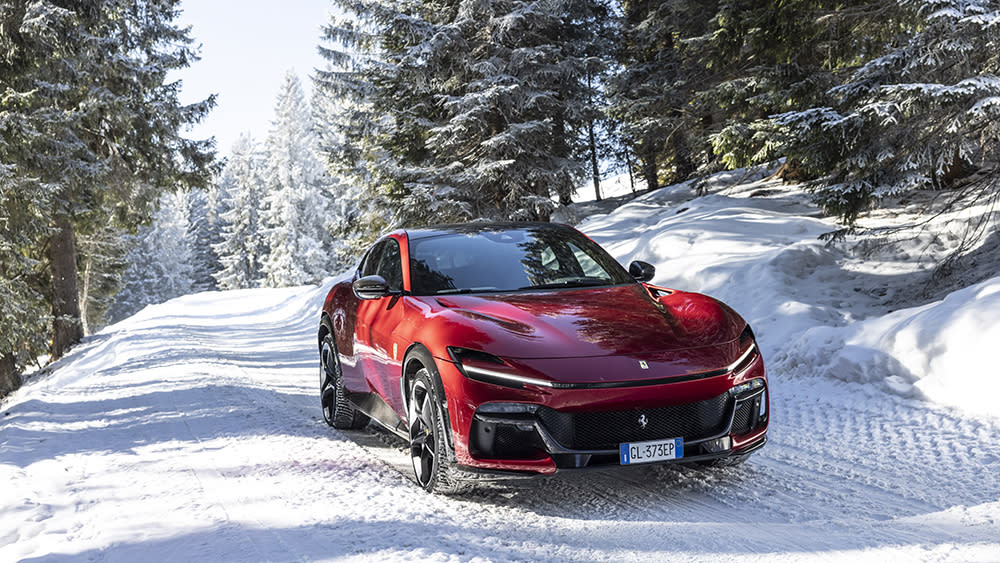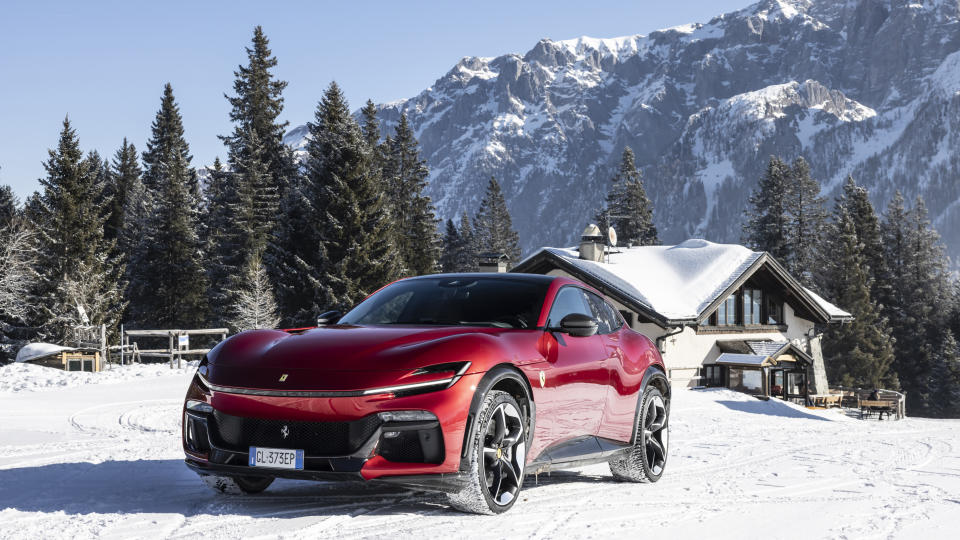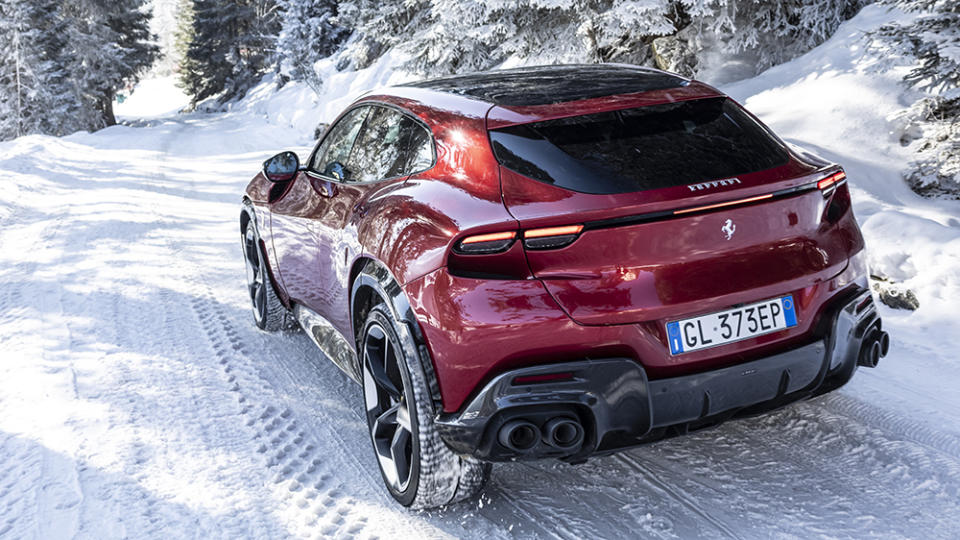First Drive: Ferrari’s Brilliant, Roaring Purosangue Is a Prancing Horse From Tip to Tail. Just Don’t Call It an SUV.

The thing to remember about Ferrari is that it marches, firmly and unfailingly, to the beat of its own batterista. At least that’s the story it likes to tell, and if you happen to suggest otherwise then a brand rep with a fashionable haircut will, firmly and unfailingly, try to help you correct course. Ferrari, you understand, is utterly immune to what other, lesser brands are up to; their vehicles are never borne of anything so pedestrian as demand.
So how to explain its first-ever SUV, the Purosangue? (Say it like the Italians do: poo-roh-SAN-gway.) First, don’t call it an SUV. Ferrari certainly won’t, which at first seems like the carmaker stubbornly refusing to admit it’s been knuckled into producing a class of vehicle it has long considered aesthetically, philosophically and perhaps even morally compromised. In fact, it’s a welcome dose of exactitude in an automotive world suddenly gone fuzzy and weird.
More from Robb Report
First Drive: Pininfarina's Carbon-Fiber Battista Is 1,900 Horses of All-Electric Fury
Watch a Guided Tour of the New 1,016 HP Ferrari SF90 XX Stradale
TAG Heuer and Porsche Team Up for a Carrera Chronograph With a Powerful New Movement
Not too long ago, “SUV” meant something specific—truck-based, body-on-frame—that the Purosangue decidedly isn’t. Actually, this 2+2 fastback is technically a crossover—not that Ferrari’s in a rush to claim that term, either. This minor linguistic glissade reflects the accelerated evolution of the modern automobile, with all its odd new mutations. And since cars, like tailoring and television, no longer slot into a few neat categories, who’s to say we shouldn’t want a Ferrari with four full-sized seats and some ride height? Especially if it comes with a howling, naturally aspirated V-12 with 725 horsepower.

It’s certainly the right vehicle for an Italian jaunt along the narrow, often cragged roads that slalom through the snowcapped Dolomites. Yes, it’s bigger and heavier than your traditional grand tourer, but so are modern NBA point guards compared to their predecessors, and that’s hardly considered a disadvantage when they retain the requisite speed and agility. And make no mistake, the Purosangue moves: zero to 62 mph in 3.3 seconds, a top speed of 193 mph, independent four-wheel steering and active suspension technology that plays the neat trick of smoothing the asphalt’s creases while still letting you feel what’s happening beneath the front rubber. There are huge column-mounted paddle-shifters, a transaxle layout that allows for a finely balanced 49:51 front-to-rear weight distribution and a redesigned intake manifold that optimizes available torque while retaining max power. You know, proper driver’s stuff.
On twisty mountain roads and snow-packed backwoods trails the Purosangue gallops and snorts and tears through corners, eager to kick out its rear but easily reined in with a touch of countersteer. In other words, it moves and feels like a Ferrari—in all but the steering, anyway. Gone is the featherweight, telekinetic magic of the marque’s low-slung two-seaters, replaced with a precise and linear system that’s nonetheless so blandly weighted and lifeless on-center that you expect to look down and see an Audi badge. Of course, with a dry weight of 4,482 pounds, some concessions to mass are to be expected; still, while you often forget you’re behind the wheel of a crossover, you also sometimes forget that you’re driving a Ferrari.
A press of your right foot is all the reminder you need. A whack of the throttle sets off such a furious, snarling roar it’s like waking a lion with a surprise proctological exam. Besides, from the outside, no one would mistake this for anything but a Ferrari. “Purosangue” means “thoroughbred” in Italian, and the lean, athletic form looks the part. The sensually creased sheet metal seems to float like naughty origami above the all-new aluminum spaceframe chassis, and boasts such cleverly advanced aerodynamics that it negates a rear wiper: at speed, the back window is squeegeed clean by nothing but a well-directed rush of wind.

There are other notable absences. While you’ll discover plenty of headroom inside the deceptively spacious interior, what you won’t see is a center console: The undulating, leather-wrapped dash creates separate cockpits for both front occupants, with a separate screen for each—and you won’t find GPS on either; clients apparently insisted they’d prefer their phones do the navigating. Instead, enjoy Ferrari’s very first massaging seats up front and the same gear selector, cleverly shaped like an old-school open-gate shifter, found in the Roma coupe.
The most surprising thing about this most surprising Ferrari is the allocation: Maranello says it’s limiting production to 20 percent of its annual vehicle sales. That’s a sharp swing from the status quo. Porsche, which kicked off the speed-ute trend with the Cayenne two decades ago, proved the category to be a slam-dunk rainmaker—by 2016, seven out of 10 Porsches sold were utility vehicles—which is why every luxury and performance manufacturer has since jumped into the game. Are we to believe that Ferrari alone isn’t interested in a similar revenue stream, especially considering this car’s $393,350 price tag and what’s sure to be insatiable demand?
Perhaps that edict will only apply to the V-12 version—maybe, later, a V-8 (or V-6) variant will emerge and go into wider production. Or possibly Ferrari will simply renege on the whole idea in a year or two. But maybe Ferrari really is marching to the beat of its own drummer here. After experiencing the brilliance of the once-unthinkable Purosangue, I wouldn’t suggest otherwise.
Best of Robb Report
Sign up for Robb Report's Newsletter. For the latest news, follow us on Facebook, Twitter, and Instagram.

